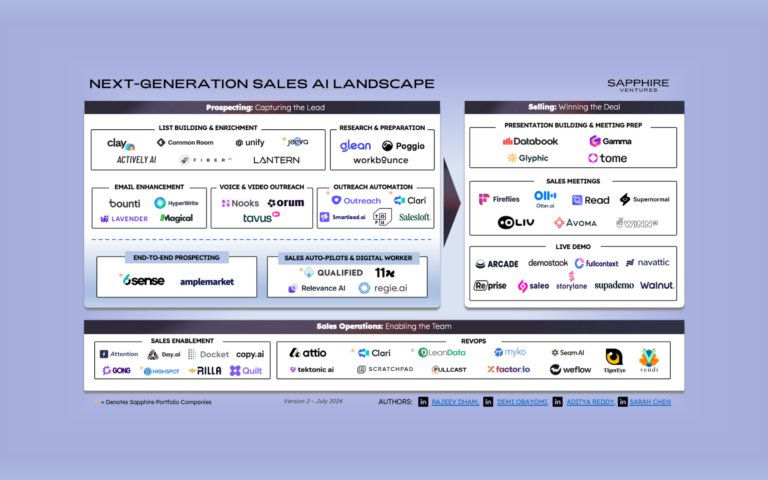We recently hosted our Next-Gen Tech Stack Forum, a technologist summit in San Francisco bringing together startups redefining the foundational tech stacks of the enterprise with technical executives from Sapphire Ventures portfolio companies and large enterprises.
Here’s a quick rundown of the day’s memorable moments:
Microservices as the (successful) evolution of SOA: Composability has been a journey throughout the history of software. But without the right cloud-native technologies and toolsets, the SOA practitioners of years past were at a loss to effectively implement composable architecture — despite useful foundational concepts. Several speakers, including Chad Arimura, co-founder and CEO of Iron.io, described microservices as improved avatars of SOA, this time powered with a tech stack (APIs, containers, cloud infrastructure) that could do justice to the original principles.
- Microservices as the gateway to leaner organizations: William Morgan, CEO of Buoyant, talked on a microservices panel about his first-hand experience handling the storied breakup of the Twitter monolith in 2010. Beyond the increased code ownership and agility, the biggest and most unexpected benefit he sees for any engineering organization making the microservices shift is around sharply-clarified and efficient communication protocols between teams owning discrete services. Illumio CTO and Founder PJ Kirner talked about how continuous delivery and containerization place additional pressures on existing security approaches. There was general agreement that security is an under-served portion of the microservices ecosystem, and companies that can effectively secure these new environments could unlock a key opportunity.
- From Legos to Minecraft — all about abstraction: Chad Arimura from Iron.io drew parallels in his keynote talk between how different generations of children play and the technical paradigms of each era. The “deep connection with the physical world” experienced by the Lego connoisseurs of years past (read: any technologist 25 and over) is giving way to the world of Minecraft and abstracted, purely digital experiences for the next breed of developers. Software will be written increasingly in an abstracted environment, amid a “serverless” context where coders will be able to create without thinking of hardware.
- “If you’re lucky, your best developers will be lazy”: In the words of Jos Boumans, VP of technical operations at Krux and speaker on our DevOps panel, the most creative developers will often seek easy ways to do repetitive things so they can focus on the fun stuff — writing new code and building cool stuff. Now, talented slackers across enterprises have the toolset and proven methodologies at hand to make automated delivery a reality. Smart enterprises will embrace this desire to automate repeatable tasks and leave their best minds to focus on innovation.
- DevOps will succeed because robots aren’t on Facebook: In an animated talk on how the singularity is extending to the enterprise, Baruch Sadogursky, chief developer advocate at JFrog, expanded on the drastic benefits around productivity, accuracy and version control of having bots (versus web-surfing humans) drive code creation and deployment. Still, areas remain where human intervention is optimal, such as QA testing, which requires greenfield thinking about myriad possible failures. Ultimately, though, JFrog envisions a future with zero human intervention from development to production. And while it’ll require an interim reskilling of developers, automation will ultimately drive the industry forward.
- Code ownership as critical: Across both the microservices and DevOps tracks, the rallying cry for “you built it, you fix it” mantra was unanimous. Code ownership and developer accountability are the name of the cultural game with DevOps, and microservices architectures are a necessary enabler. The infamous 2am bug-fixing call that all developers know, and uniformly dread, can go a lot more smoothly when code ownership is drastically clarified.
- NOC, NOC — anybody home? Todd Vernon, founder and CEO of VictorOps, talked about the changing reality for NOCs (Networking Operations Centers) on the infrastructure panel. Life was simpler when companies deployed every month or even weeks. With continuous delivery and distributed architectures, centralized NOCs grapple with daily deploys and face a new set of questions about how to remain relevant. A new set of tools and structural changes in the NOC model could well be the answer.
At Sapphire, we firmly believe the new enterprise tech stack is fundamentally different and full of potential. Our recent investments in the likes of Iron.io, JFrog, PubNub and CloudHealth Tech are a reflection of this belief.
Companies should waste no time in charting their own roadmaps for adopting the new world. The cycles of creative disruption in our industry are shrinking from 5–10 years to 18–24 months, and only those that truly embrace the new stack are well positioned to come out on the right side of the next cycle.




